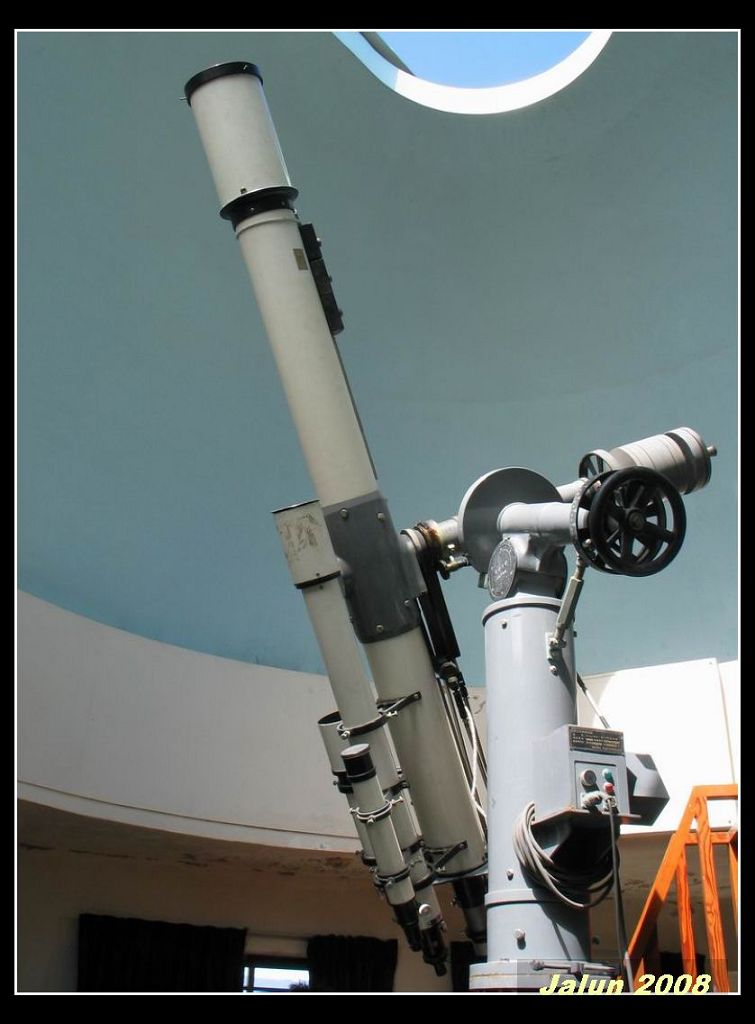  |
|||
自動遙控 40 公分蓋賽格林反射式望遠鏡,並配備有研究等級的 Apogee CCD 。 |
Auto remote control Cassegrain reflector with 40cm cover, and equipped with study level Apogee CCD |
||
  |
新圓頂天文台的 15 公分折射式望遠鏡配加 Hα 濾鏡,可進行太陽色球日珥的觀測。 |
|
|||||||||
|
|
|||||||
天文是人類歷史上最古老、也是最尖端的一門科學。近年來科技的進展以及天文學上的發現、如太陽系外諸多行星系統的發現、已讓科學家了解到我們所處的地球並非是一個封閉獨立的系統。地球上自然環境的變遷、演化、以及巨大災變,均與地球周遭的環境息息相關。因此要檢驗地球科學中的一些基本模型、理論或假說,觀察自然環境在不同物理條件下的演變,再也不能僅局限於對地球本身的觀測,因為地球已非唯一的實驗室。
|
Astronomy is one of the oldest sciences back to ancient times, and yet still at the frontiers of research in our modern age. Unlocking the secrets of the evolution and structure of the Universe helps earth scientists better understanding the origin and cosmic environments of our planet. As revealed by recent eruptive progress in astronomy, for example - the discoveries of more than 2 hundred planets outside the solar system, scientists have realized that to study what made the Earth as it is now, as well as its past and future, the Earth cannot be treated as an isolated system anymore; the global changes of the physical conditions and cataclysmic events on this planet could well be related to astronomical effects. On the other hand, the Earth is no longer the sole physical place to obtain or examine our knowledge in earth sciences, other planets, stars or space between these cosmic objects can also provide additional or terrestrially not available laboratories to test hypotheses or verify various theories in natural science.
|
|
同樣在生命科學的課題上,僅以在地球上取樣的資料,來研究生命的起源以及維繫生命成長的環境,已是舊的思維;現今的研究,還要擴展到太陽系內其他行星、衛星、彗星及小行星,以及銀河系中的星際物質。研究星際介質中可能存在的各種複雜有機分子,則能幫助我們人類進一步瞭解在銀河系中,生命最初是如何透過各種物理及化學機制開始的,以及之後生命是如何散播、分布到銀河的各個角落,包括我們所在的地球。 |
In
addition to the physical Earth, it also becomes clear that only from astronomical aspects, we can possibly answer some fundamental questions in life science, such as the origin of life and conditions to maintain a habitable environment. Scientists have therefore already extended the scope of investigating the biological universe from Earth to other planets, satellites, asteroids, and comets in the solar system, even interstellar space in the Milky Way. Studies such as analysis of complex organic molecules in the interstellar medium can provide astronomers with further clues to how life got started by what physical and chemical processes, and how it spread across the Milky Way, including our Earth.
|
所以地球 ( 環境 ) 科學及生命科學的發展趨勢,以及兩者整合,乃與天文學的關係密切。天文生物學 (astrobiology) 及比較行星學
(comparative planetology) 的興起,正是很好的例證。美國太空總署所推動的大型計畫「起源」 (Origins) ,更是一個整合天文學、地球科學 ( 地質、氣、海洋 )
、化學、生命科學、及物理學來研究從生命起源到宇宙起源的實際例子。師大地科系天文組提供一系列由大學部到研究所的課程,培育具有現代觀的中學教師以及天文相關人才。
|
Astronomy is becoming an increasingly essential part in earth sciences, particularly in the fields involving life science; the emergence of astrobiology and comparative planetology in recent years just reflects this growing trend. NASA’s Origins program, which integrates astronomy, earth sciences (geology, atmospheric science, and oceanography), chemistry, life science, and physics to search for origins of everything, from life to our Universe, also strongly indicates the necessity of multi-disciplinary collaboration in astronomy and earth sciences. With an understanding of the importance of commutations between astronomy, earth sciences, and life science, the Astronomy program of NTNUES provides a series of lecture courses, at both undergraduate and graduate levels; the curriculum is designed to bring students an appreciation of the modern view of the Universe, and to prepare them to pursue a professional career in astronomy or to teach in high schools.
|